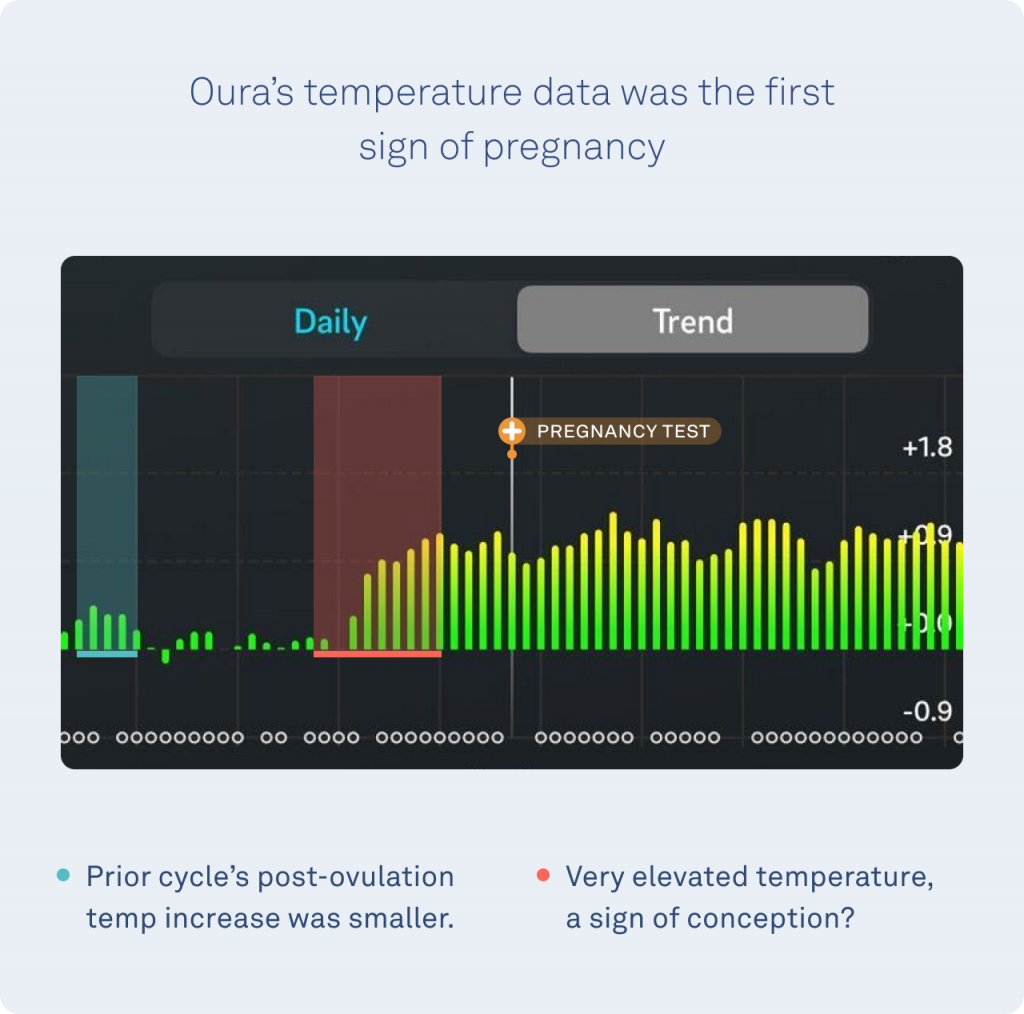In April 2021, the University of California San Diego and Oura announced a pregnancy study to see if the Oura Community could help uncover key patterns of pregnancy by sharing data from previous pregnancies along with surveys of their personal experiences.
Over 1,000 people joined the study, and today, we’re excited to share results from a preliminary analysis of 30 pregnancies.
These results show that researchers would have been able to identify pregnancies early – an average of 5.5 days after self-reported conception and an average of 9 days before they received a positive at-home pregnancy test.
| Member Tip: Oura members who are pregnant can now access Pregnancy Insights, which offers in-app educational resources and the ability to track gestational age. |
READ MORE: How to Use Pregnancy Insights
A Message From The Researchers
“We were amazed at the response from the Oura Community. The positive feedback and the number of people who responded were heartening. Thank you to everyone who participated and facilitated the study, and to everyone who reached out telling us what they would like to learn next – stay tuned! The data is incredible, and this is only the first of many findings.” – Prof. Benjamin Smarr. principal investigator and study co-author, UCSD
What Patterns Did They Find?
These initial results show that continuous body temperature may be a viable tool for passive, early pregnancy detection. Oura’s temperature data is able to spot a unique pattern of temperature increasing around the time of conception that is consistent with known rises in progesterone in early pregnancy.
Many members of the Oura Community have already reached out to share this pattern in their data, like the example here:

UCSD’s work expands on these patterns. With more findings on the way, here are the key results so far:
- Temperature May Provide An Early Alert: Oura’s nighttime temperature data was able to help identify pregnancies early, on average 9 days before these individuals received a positive at-home pregnancy test and only 5.5 days after conception (self-reported). While this study looked at past data (and therefore didn’t send “live alerts” to these individuals), this highlights the potential for developing future tools to help clinicians, researchers, and individuals identify pregnancy onset earlier.
- Temperature Patterns Appeared For Everyone: All 30 pregnancies showed a clear temperature increase following self-reported conception that was identifiably higher than the increase that typically occurred during the luteal phase of their menstrual cycle.
- 24/7 Temperature Reveals Different Clues: Oura measures temperature data once every minute, 24 hours a day. Although past research using Oura has shown that daytime temperature patterns revealed fertility clues, this study spotted patterns of elevation specifically in Oura’s nighttime temperature data, highlighting how different times of day may yield different clues, depending on which aspect of fertility is being studied.
These results are encouraging that Oura’s temperature data could one day be used as an early screening tool for women who may become pregnant. Wider studies and future validation across diverse populations and clinical settings will be necessary to make such tools reliable and accessible.
How Early Is This Temperature Alert?
Oura’s nighttime temperature data revealed a temperature increase that has the potential to enable early alerts so these individuals could discover they are pregnant on average 9 days before receiving a positive at-home pregnancy test.
Although temperature increases are well established in the first trimester, current pregnancy detection methods rely on consistent use of an oral thermometer and only signal a pregnancy 20-30 days after conception (i.e., after the time an over-the-counter pregnancy test could be used), whereas Oura temperature data showed unique temperature increases an average of only 5.5 days after conception.

“It is possible that, because oral temperature has been relatively slow to rise after conception in past studies, researchers haven’t aggressively pursued other temperature applications,” says Dr. Azure Grant, study co-author.
She continues, “It is exciting that by selecting a different location (finger instead of mouth), by increasing the frequency of measurement (once per minute instead of once per day), and by adding some careful data cleaning, that a much clearer signal of pregnancy emerged in this initial cohort.”
“Oura generates 1,440 temperature data points in a day and that enables earlier detection of temperature increases because it ensures temperature patterns aren’t missed due to natural fluctuations and rhythms in an individual’s temperature,” concludes Grant.
Why Does Early Detection Matter?
These early results have positive implications to help individuals know they are pregnant sooner.
Even though women make up a majority of the global population, and the large majority of women experience at least one pregnancy, pregnancy is underserved in digital health. The few studies that have been done suggest the average woman learns she is pregnant 3-4 weeks after conception, though a large fraction still may not know 2 months after conception.
While the participants in this study found out they were pregnant ~14.5 days after conception, they were aware of their pregnancy earlier than the average population, suggesting that there’s an even larger awareness gap that Oura may be able to help close.

What’s Next?
The UCSD research team is continuing to search for other patterns that may reveal clues about the full trajectory of pregnancy, miscarriage, preterm birth, delivery, interactions between partners’ data, and more. Results will be shared publicly as soon as they are available.
“This research highlights how high resolution, continuous data captured by the Oura Ring can enable rapid discovery of new scientific insights and accelerate the development of solutions that could help improve pregnancy detection and monitoring,” says Shyamal Patel, Head of Science at Oura.
RELATED: Oura Empowered Me To Care For Myself During Pregnancy

*A message from the UCSD research team on the preliminary nature of the results:
“These preliminary results tell us that we should be exploring the potential uses of continuous temperature for pregnancy detection and monitoring in large and diverse clinical settings where we can compare self-report, ground truth clinical data, and continuous metrics. These larger analyses will allow us to assess the variability of temperature features in early pregnancy, including false positives and false negatives – which are essential if this or related techniques will be developed for real-world use. We are far from having a solution to early pregnancy testing, but we are encouraged by this early success”. – Dr. Azure Grant and Dr. Ben Smarr
Note: Self-reported conception was in response to this question – “If you know when you likely conceived, please list the most likely date (please leave blank if you don’t have a strong sense of this).”




